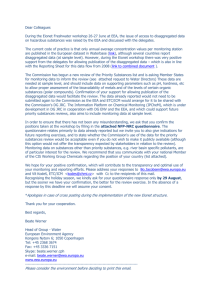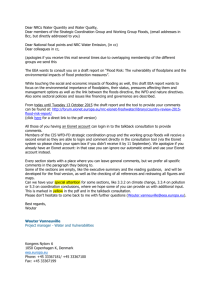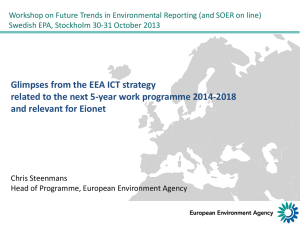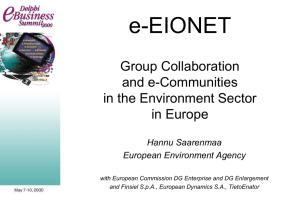EEA answers (in blue) for clarification of the hazardous substances
advertisement
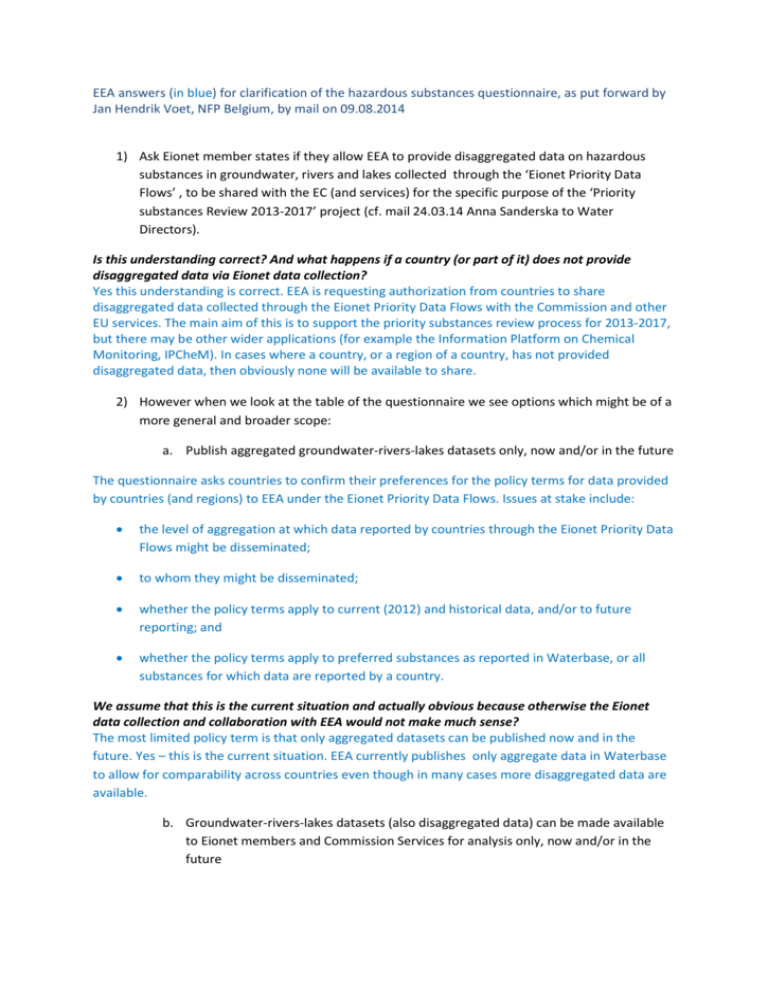
EEA answers (in blue) for clarification of the hazardous substances questionnaire, as put forward by Jan Hendrik Voet, NFP Belgium, by mail on 09.08.2014 1) Ask Eionet member states if they allow EEA to provide disaggregated data on hazardous substances in groundwater, rivers and lakes collected through the ‘Eionet Priority Data Flows’ , to be shared with the EC (and services) for the specific purpose of the ‘Priority substances Review 2013-2017’ project (cf. mail 24.03.14 Anna Sanderska to Water Directors). Is this understanding correct? And what happens if a country (or part of it) does not provide disaggregated data via Eionet data collection? Yes this understanding is correct. EEA is requesting authorization from countries to share disaggregated data collected through the Eionet Priority Data Flows with the Commission and other EU services. The main aim of this is to support the priority substances review process for 2013-2017, but there may be other wider applications (for example the Information Platform on Chemical Monitoring, IPCheM). In cases where a country, or a region of a country, has not provided disaggregated data, then obviously none will be available to share. 2) However when we look at the table of the questionnaire we see options which might be of a more general and broader scope: a. Publish aggregated groundwater-rivers-lakes datasets only, now and/or in the future The questionnaire asks countries to confirm their preferences for the policy terms for data provided by countries (and regions) to EEA under the Eionet Priority Data Flows. Issues at stake include: the level of aggregation at which data reported by countries through the Eionet Priority Data Flows might be disseminated; to whom they might be disseminated; whether the policy terms apply to current (2012) and historical data, and/or to future reporting; and whether the policy terms apply to preferred substances as reported in Waterbase, or all substances for which data are reported by a country. We assume that this is the current situation and actually obvious because otherwise the Eionet data collection and collaboration with EEA would not make much sense? The most limited policy term is that only aggregated datasets can be published now and in the future. Yes – this is the current situation. EEA currently publishes only aggregate data in Waterbase to allow for comparability across countries even though in many cases more disaggregated data are available. b. Groundwater-rivers-lakes datasets (also disaggregated data) can be made available to Eionet members and Commission Services for analysis only, now and/or in the future This option 2b) is broader than 1) as this could be applicable for whatever data request (other than the Review mentioned above) from EC services or Eionet members now and in the future. Is this understanding correct? All options refer to data reported to the EEA under the Eionet Priority Data Flows. This option is broader since by selecting it the reporting country agrees to make disaggregated data, for those countries/regions and water bodies for which it has been reported, available to Eionet members and Commission services. c. Groundwater-rivers-lakes datasets (also disaggregated data) can be made available publicly This is definitely much broader than the request under 1). Is this understanding correct? Yes this is broader since the audience to whom data can then be disseminated is widened to include the public, i.e. data could be published. 3) A difference is made between ‘preferred’ substances and ‘all’ substances now and in the future What is the rationale of this question, And are we still talking about data collected via Eionet Priority Data Flows or also about other reporting sources? What is the relationship/interpretation between these last two lines and the previous three? Under Waterbase, data is published for a selected number of preferred substances. In their reporting, countries may include monitoring data for a wider range of substances, including for example river basin pollutants. This request asks whether the choices for data policies for country should apply to monitoring data on the substances currently published in waterbase, or to monitoring data for all substances reported by a country. 4) Some questions from a non-expert (so they might be totally irrelevant) on the questionnaire table as a whole: Why is at the top of the questionnaire mentioned ‘Reporting to SoE emissions’? What does it mean? We apologise for this, it should have been SoE GW - Rivers – Lakes Are the terms ‘groundwater – rivers – lakes’ referring to the Eionet Data Flows or are they referring to whatever data EEA might have in its database from monitoring stations on groundwater – river – lakes even from another origin? We are referring specifically to data reported under the Eionet Data Flows When the term ‘datasets’ is used does the question only concern data on the ‘hazardous substances’ or are there also other data for which the option would be applicable? Data on hazardous substances would need to be complemented by data on the monitoring stations and some data characterising the water. Hence the options will also capture such complementary data needed to make sense of the hazardous substances data.
